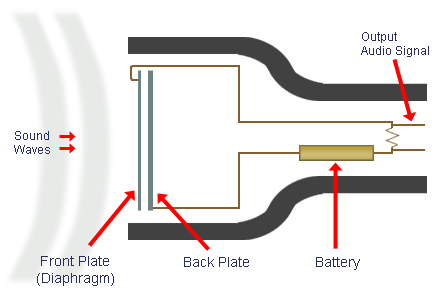If you are considering getting a microphone and you want to know why condenser mics are so sensitive, then here is the answer for you
A condenser mic is more sensitive because due to its extremely low mass, the diaphragm of a condenser mic can follow sound waves accurately with a heavy moving coil attached.
This is why condenser mics are more sensitive and offer superior sound quality when compared with other microphones.
How a condenser Microphone works

The British call them “capacitor microphones” – and for a reason, too.
You may remember from physics class that a capacitor is essentially two metal plates in close proximity.
The closer they are, the higher the capacitance.
A condenser capsule is constructed similarly.
It consists of a thin membrane in close proximity to a solid metal plate.
The membrane or diaphragm, as it is often called, must be electrically conductive, at least on its surface.
The most common material is gold-sputtered mylar, but some (mostly older) models employ an extremely thin metal foil.
When sound waves hit the diaphragm, it moves back and forth relative to the solid backplate.
In other words, the distance between the two capacitor plates changes.
As a result, the capacitance changes to the rhythm of the sound waves.
Voilà, we have converted sound into an electrical signal.
The capsule signal itself, however, is much too “fragile” to be connected to other pieces of gear.
The condenser capsule’s output voltage is actually quite high, but it produces almost no current, because so little energy is stored in this small capacitor.
It requires what is called an “impedance converter”, a circuit that buffers between the capsule and the outside world.
The impedance converter makes the signal more “sturdy” by making more signal current available.
Types of condenser Microphones
There are two different types of condenser mics: small and large diaphragm.
Large-diaphragm microphones are most often the choice for studio vocals and any instrument recording where a deeper sound is desired.
A large-diaphragm microphone warms up the sound of what it’s recording, which also leads to the myth that most LDMs reproduce low frequencies better than small diaphragm mics.
Here is an article I wrote, 10 best condenser mic
In fact, small-diaphragm mics are much better at reproducing everything evenly, including bass.
I wrote an article comparing the best condenser microphones for vocals which you can check here
You’ll want a pop screen if you’re using a condenser microphone for vocals; they’re so sensitive to transient noises that the p and sh sounds you make will cause distortion.
If you’re looking for a microphone with a large diaphragm, a good option is the Audio-Technica AT2035, which provides a natural sound.
You can use it in your home, at a recording studio or in live performances; its cardioid studio condenser ensures low background noise.
Small-diaphragm microphones are the best choice when you want a solid, wide-frequency response and the best transient response, as for recording things like stringed instruments.
SDMs are also the preferred choice for concert taping.
For a small-diaphragm condenser microphone, check out these two options:
- The Rode NT1KIT Condenser Microphone Cardioid features a pressure gradient acoustic principle, has a frequency range of 20Hz to 20kHz and comes with an SMR shock mount and dust cover.
- If you’re looking for a seriously over-top condenser microphone with a small diaphragm, the AKG Pro Audio C414 XLII is your best bet. The microphone delivers incredible sound quality for lead vocals and solo instruments and has nine selectable polar patterns, plus three attenuation levels for close-up recording or high-output sources. And three switchable bass-cut filters help to reduce wind noise and stage vibration.

Trackbacks/Pingbacks